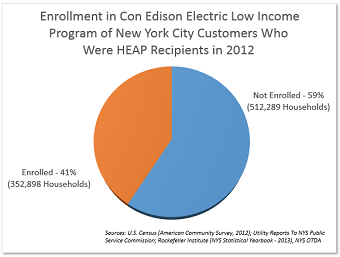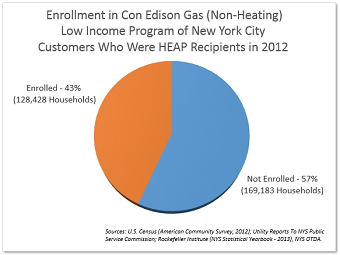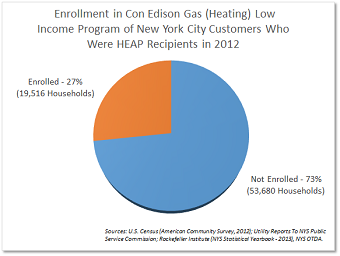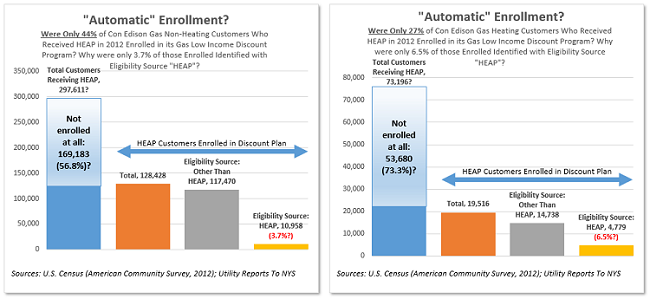Con Edison Low Income Reduced Rate Program: Eligible, But Not Enrolled?
This is the first in a series about enrollment in the low income reduced rate programs of New York State’s major public utilities.
Con Edison Low Electric and Gas Low Income Rate Program
Serves: New York City and Westchester (This analysis and discussion is limited to the New York City service area)
Reduced Rate Program: YES, for gas and electric
Reductions Allotted per Customer:
Electric: $9.50 reduction on the standard electric bill, one-time reconnection fee waiver
Gas: SC1 (non-heating customers): $1.50 reduction on “monthly minimum charge”
SC3 (heating customers): $ 0.4880 per therm reduction for the 4-90 block with a $7.25 reduction on the “monthly minimum charge”Analysis and Discussion
Con Edison is the largest utility in the state serving the largest low-income customer population and its rates are among the nation’s highest. It is thus important that the Con Edison low income reduced rate programs be highly effective and well administered. Recent findings indicate major issues regarding eligibility, enrollment, and efficacy.
First is the matter of ELIGIBILITY, the simple question “Do I qualify?” To be eligible for Con Edison’s gas or electric discount programs, one must qualify for other forms of public benefits for low income persons, by demonstrating need “officially” to agencies of government which carefully examine financial eligibility. This eliminates duplicative time and expense in assessing eligibility, and it encourages those needing reduced utility bills also to seek other household assistance for which they are eligible, such as Home Energy Assistance or SNAP (food stamps). Thus, enrollment in programs such as HEAP, SNAP, SSI, and TANF/SafetyNet automatically qualifies customers for Con Edison’s electric low income program. Enrollment in the same programs, as well as Medicaid, qualifies you for Con Ed’s gas low income program.
Already we encounter an issue, the arbitrary refusal to allow Medicaid qualification for the electric low income program: A Medicaid recipient who is not receiving aid in the other eligibility-conferring categories is eligible for Con Edison’s reduced natural gas service rates, but not the reduced electric rate. Apparently, Con Edison refuses to accept the Medicaid criterion simply as a means of avoiding enrollment for the reduced electric rate. In their own words in its 2013 rate case, Con Edison said that “adding Medicaid could significantly increase enrollment in the electric program,” which would increase “cost” to Con Edison. Actually, reducing the rate for low income customers does not increase Con Edison costs, it simply means that it recovers its costs of service from other ratepayers better able to afford the bills. (As you’ll see, a major shortcoming of low income rate programs in New York is utilities trying to hold onto static, unchanging amounts for rate reductions, regardless of enrollment numbers, economic climate, etc.) Thus, at Con Edison, a policy endures that excludes Medicaid recipients, even though they automatically qualify for Con Edison’s reduced gas rates, National Grid (KeySpan-NY) reduced gas rates, and reduced rates for telephone service in the state and federal telephone Lifeline program.
Even with arbitrary eligibility criteria put aside, we encounter issues with ENROLLMENT. In a process called auto-enrollment or computer data “matching,” Con Edison cross-references its customer list with assistance program enrollment records from the New York City Human Resources Administration / Department of Social Services (our findings are limited to New York City; the trends, however, tend to repeat in Westchester). Auto-enrollment is where enrollment in programs like HEAP come into play: if you’re enrolled with HEAP, theoretically, you should not only qualify for Con Ed’s electric and gas low income programs, you should also be found through this “automatic” process and be billed the lower rates for gas and electric service. But problems arise almost immediately, and eligible customers seem to be getting lost rather than found.
Auto-enrollment previously was relegated to a once-a-year exercise (not allowing for realistic changes of economic circumstance, like the loss of a job, that tend to occur far more rapidly and create “churn” in the population of current aid recipients) but even then, Con Edison has been inconsistent in administering this process of records matching (referred to as “reconciliation”). Rate case information revealed that Con Edison and HRA went 20 months, from April 30, 2010 to December 30, 2011, without completing a reconciliation. Information that surfaced in the rate case indicated that the most recent match took approximately 15 months to complete. Imagine qualifying for a reduced rate program at a time when you are temporarily needy for a few months, and need to put food on the table and keep the lights on, but you don’t get the reduced rate because the once-a-year enrollment process was delayed or ineffective.
Frequency of reconciliation isn’t the only issue (and it should be working better, because Con Edison upped its reconciliation to twice a year): EFFICACY is seriously in doubt. Recent analysis by the Utility Project into the number of HEAP-qualifying customers versus those actually enrolled in Con Ed’s electric and gas low income programs suggest a staggering problem: an apparent major failure of the auto-enrollment process. Cross-referencing HEAP enrollment data with figures from the U.S. Census Bureau, as well as the New York City DHR/DSS, the New York State Office of Temporary Disability and Assistance (NYS OTDA) and the New York State Statistical Yearbook, we discovered significant disparities: in 2011, there were 865,186 actual HEAP recipient households in New York City (in 2012, peak HEAP caseloads numbered 869,683). Of that eligible population, only 352,898 (on average) were enrolled in Con Ed’s electric low income discount program, meaning over 500,000 HEAP households in New York City —half a million—may have been eligible, yet not enrolled, through the “automatic” enrollment process.
The gap widens with enrollment for the reduced gas rates, although analysis here is more complex and somewhat muddied due to limitations of the data. Con Edison’s gas program is divided into heating and non-heating usage, and the Company doesn’t publicize the number of its customers by borough or neighborhood that use gas for primary heating. More study is needed given the significance of the issue, but even a simple comparison of HEAP enrollment versus gas non-heating program enrollment indicates the same failure of the “matching” mechanism: in 2012, only an average of 128,428 HEAP recipients were enrolled in Con Edison’s low income gas non-heating program, meaning over 160,000 additional customers who should have been enrolled weren’t. Instead, they were paying higher rates than others in the same economic circumstance. Why?
Again, more research is needed—and more data should be made available. But the disparity is troubling, and gets worse. In the heating component of the gas low income program, the percentage of customers potentially eligible to participate but who aren’t enrolled is drastically higher—about 73% to be exact. If Con Edison gas heating customers were receiving HEAP grants at the same overall rate as were households in the Bronx, Manhattan and Queens in 2012, the gap between eligible and enrolled in the heating part of the plan would exceed 50,000. That’s unlikely, since Con Edison’s Queens service area is a relatively small, affluent part of that borough. On the other hand, if Con Edison gas customers are heavily skewed toward low income neighborhoods in other parts of its service territory, 50,000 unenrolled low income customers becomes a bit more realistic, and likely. That’s $12.3 million in lost benefits for 2012 alone, a figure that would rise to about $20 million for 2014—if these suppositions are correct. Given the consistency of problems with Con Ed’s matching mechanism, “automatic” enrollment failure here wouldn’t be surprising.
Can you enroll in Con Ed’s low income discount program yourself? Sure. Like many utility low income programs, Con Ed allows for self-enrollment. Unfortunately, the Company provides customers with next-to-no resources to enroll yourself, nor much information about the program. If you have internet access, try a simple Google search for “low income program Con Edison.” Unless we missed something buried deep in the pages of search results, there were only two hits returned from the Con Ed website: an FAQ link and a “Special Services” page. The FAQ explains that you’ll be given Con Ed’s low income rate if you get a HEAP grant or are on the Direct Vendor or Utility Guarantee programs, and also tells you how you can apply on your own if you meet the eligibility criteria through other means. The special services page has information about how seniors, people with disabilities, and others can obtain HEAP and special services through Con Ed but doesn’t include any information (or mention) about low income rates.
In fact, the FAQ appears to be the only page on Con Ed’s website with any indication that having a lower income may qualify a customer for reduced rates (the only other official notice we’ve seen of it is in the Residential Rights Brochure, where Con Ed actually, and significantly, says that there is a low income “rate” for income-eligible customers). And while page 4 of the Con Edison application for service says the customer can “choose the more beneficial rate”—meaning the lower rate if you’re income-eligible—there’s actually no information about the rate, no query as to whether the customer receives aid in the eligibility-conferring programs, and no opportunity to select this rate on the application form! Specific internet searches yield little and on the application itself, vague mention of a “more beneficial rate” leads to an apparent dead end; even with self-enrollment, Con Ed’s low income rate programs are elusive.
Compare this to other New York State utilities: a search of “Rochester Gas and Electric low income discount program” turned up a page called “Payment Help” with corresponding and fairly visible placement on the website’s sidebar. The same search with Central Hudson and Gas yielded a link to their “Powerful Opportunity Program,” while a simple search within the site led from the Main page to “Your Home” to a page called “Payment Assistance & Special Help“. Anyone who’s ever used a coupon knows discounts are only as good as their availability and visibility. Con Ed is essentially negating its low income rate program when it buries all evidence of it except in in an obscure FAQ and a pdf attachment.
Is Con Edison trying to deter eligible customers from obtaining the benefit of low income rates approved by the PSC? Not necessarily. But there are clearly major obstacles at work here. And enrollment shortfalls like these may be caused, at least in part, by the fact that Con Edison has “target” enrollment and total bill reduction targets for its low income rate programs. But how does this square with its maximum “targets” (i.e. budgets)? In the 2013 rate case, Con Edison proposed to eliminate Medicaid as an eligibility category for the gas low income rate in order to maintain a limit on total reductions to $38.25 million based on an estimated enrollment of 375,000 qualifying customers, even though a recent reconciliation actually increased enrollment to 435,000 customers, or 60,000 more. Supposedly, there is no ceiling on enrollment: Con Edison is not supposed to turn away any eligible applicant for its reduced low income rates. Anomalies in the matching program and well hidden information about availability may, however, be suppressing fuller enrollment.
The trend—insufficient targets/budgets despite increasing enrollment—seems to be continuing. Take Con Ed’s gas heating reduced rate program, budgeted in the most recent rate case at $8.4 million. Let’s break down those numbers and see how far that budget goes: a new $7.25 discount will total $1.7 million for an estimated 20,000 gas heating customers, leaving $6.7 million for the per-therm discount. At last year’s usage levels, the new rate would just about use up the rest of that $6.7 million. Except usage levels are up: in 2014’s first quarter alone, therms eligible for discount were up 7.5% due to this winter’s severe cold temperatures—meaning this year’s gas heating program target could very well be exceeded.
So what happens when “targets” are exceeded? For the gas program (heating and non-heating), discounts aren’t reduced, nor are eligible customers turned away; rather, the lost revenue due to the rate reduction is paid by non low income customers. The same is true for the electric low income program, to a point: if total rate reductions in the first year of the rate plan exceed or fall short 10% of the target, reductions for the next year can be reduced or increased by up to $.50 per month. If total reductions in any four months of the first year exceed 20% of the target, the Company, PSC, and other parties are supposed to meet in time to determine if additional changes should be made to adjust the rate reductions for the following year.
Compare that to the terms of a recently settled National Grid rate case, which provide that—for purposes of its low income discount program—“amounts in excess of the rate allowance will be deferred for future recovery from customers. Any under expenditures will be deferred for future use in the low income program.” Which is to say, if National Grid loses more revenue than projected due to higher enrollment in its low income program, they’ll simply recover it in the future; if they save, they’ll put that toward reductions in future years. Either way, the amount of reductions in the low income rates will not be altered.
This isn’t the time to roll back on low income energy assistance, especially in New York. According to a September 2012 article from the Fiscal Policy Institute, New York City is far behind in economic recovery since the Great Recession: “poverty has increased and incomes have fallen each year since 2008,” with residents living in “deep poverty” increasing even faster. Also, New York has the highest electric rates in the continental United States, and Con Edison’s are the highest of any major utility in New York. If Con Ed truly intends to service all qualifying low income customers with the “most beneficial rate,” it not only needs to fix its auto-enrollment process—which deserves critical and immediate attention—it needs to reconsider its eligibility criteria, make Medicaid an eligibility conferring program, and make its low income program at least reasonably visible to a vulnerable segment of its customer base increasingly in need. See CATCHING UP IS HARD TO DO – NEW YORK’S UTILITY CUSTOMERS AND THE GREAT RECESSION, Utility Project Blog, February 3, 2014.
Gerald A. Norlander
Follow New York’s Utility Project on Twitter




